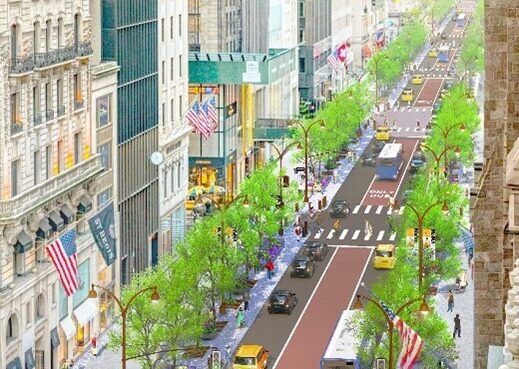New York City Mayor Eric Adams on Wednesday unveiled a sweeping $422 million redevelopment plan for Fifth Avenue, aimed at transforming one of Manhattan’s most iconic stretches into a global shopping destination. The overhaul would reduce vehicle lanes from five to three, expand sidewalks by ten feet on each side, and introduce 230 new trees along the 0.9-mile corridor between Bryant Park and Central Park.
“ No more crammed sidewalks. No more dodging traffic,” Adams said at a press conference. “We’re making Fifth Avenue more walkable, greener and safer.”
Although construction wouldn’t begin until 2028, Adams is seeking to secure the full funding in the city’s upcoming budget, set for approval by the end of June. The mayor’s office said $402 million would be drawn from city funds, while private contributions from the Fifth Avenue Business Improvement District would cover just $20 million — less than 5% of the total bill.
The stretch includes high-profile addresses like Saks Fifth Avenue, Tiffany & Co., and Trump Tower. The redesign would see sidewalks widened from 15 to 25 feet, with two traffic lanes removed entirely. The city says the aim is to emulate the pedestrian-friendly elegance of Paris’ Champs-Élysées.
But not everyone is sold. Transit and cycling advocates quickly pushed back, accusing the mayor of prioritizing luxury retailers over daily commuters.
“The mayor is throwing riders under the bus to favor luxury boutiques,” said Riders Alliance spokesperson Danny Pearlstein, as quoted by the Gothamist. “Just like Gov. Cuomo’s notorious Buffalo Billion, Mayor Adams’ Fifth Avenue Half Billion is a huge corporate giveaway at New Yorkers’ expense.”
Cycling advocates expressed alarm over the removal of one of the avenue’s two dedicated bus lanes and the absence of any protected bike path in the plan.
“This shortsighted ‘vision’ snubs bus riders, pedestrians and people on bikes alike,” said Ben Furnas, executive director of Transportation Alternatives. “It’s going to push cyclists onto sidewalks, endangering pedestrians and increasing tension on footpaths.”
City officials defended the cost, noting that a large portion of the budget is earmarked for critical underground infrastructure work, including water mains, sewer lines, and utility upgrades, needed to support the new streetscape. The entire roadway would need to be dug up and rebuilt.
The price tag has risen sharply since early estimates pegged the project at $350 million. The city struck a deal with local merchants last fall to move forward with the transformation, though details on the private sector’s financial role remained unclear until this week.
Despite the backlash, Adams stood by the public investment. “Fifth Avenue generates more than $111 billion in total economic output each year,” he said. “Investing here means investing in New York City’s future.”












